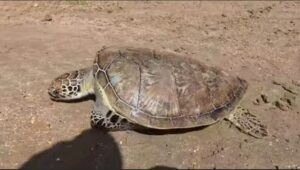 BY VAHAB JISKANI
BY VAHAB JISKANI
On the western edge of Karachi, where the Arabian Sea kisses the land, lies Turtle Beach, a quiet stretch of sand in Hawksbay that turns into a miracle ground every year. Dozens of green sea turtles (Chelonia mydas) emerge from the waves under the moonlight to lay their eggs. These eggs, buried deep in the sand, carry the fragile promise of a species that has existed for more than 100 million years. Hawksbay is one of the few remaining nesting sites in Pakistan, and its ecological importance cannot be overstated.
But this same sacred coastline is also the setting for a long standing human conflict between tradition and science, belief and law.
In the nearby community of Maripur, local fishermen have passed down stories and remedies about the turtles for generations. For them, the eggs are more than just food they are medicine and sometimes even spiritual protection. During a field interview in January 2025, Hazoor Bux, a 48 year old fisherman, shared what he calls his “elders’ wisdom”:
Our elders believed that turtle eggs could cure asthma and cough. Even today, people say drinking a raw green turtle egg helps with breathing problems. The eggs are also used for protection against black magic some believe eating seven eggs makes you immune to any spell.
The green turtles, with their distinctive olive shells, are the most common along this coast, which is why locals traditionally use their eggs more frequently. Yet this deeply rooted practice now directly violates wildlife protection laws, as the green turtle is officially recognized as a threatened species. Despite the ban, illegal egg collection continues, often at night when conservation patrols are limited.
Modern science, however, completely contradicts these traditional beliefs. According to S. Katni et al. (2022) in Frontiers in Marine Science, turtle eggs are unsafe for human consumption. The researchers found that the eggs contain pathogenic bacteria, including Salmonella spp., which can cause serious foodborne infections. The study also identified alarming levels of heavy metals such as lead, mercury, cadmium, and zinc, all of which pose long-term health risks to humans, particularly children and pregnant women.
Further studies strengthen this concern. V.V. Ebani et al. (2023) in Animals (MDPI) reported that turtles and their eggs can transmit zoonotic diseases infections like Chlamydiae and Mycobacteria that can spread from animals to humans. The Turtle Foundation (2018) documented multiple cases of chelonitoxism, a type of poisoning caused by consuming turtle products, sometimes resulting in fatalities. These findings demonstrate that turtle eggs are not a cure they are a potential poison.
Conservationists are doing everything they can to protect what remains of the population. Ashfaq Memon of the Sindh Wildlife Department, in an interview with The Express Tribune (2025), reported that “between September 2024 and January 2025, 403 female turtles came to Hawksbay and Sandspit, but only 180 successfully laid eggs. Nearly 20,756 eggs were collected and relocated to protective pits, resulting in 11,082 hatchlings released into the sea.”
These statistics highlight both progress and peril. Despite improved conservation measures, illegal human interference continues to threaten the turtles’ nesting process. The conflict is not just environmental it’s cultural. People like Hazoor Bux stand at the intersection of belief and awareness, where generations of inherited faith are slowly being questioned by education, science, and law.
Hawksbay’s Turtle Beach is more than just a natural site it is a living classroom about coexistence. Each wave that touches the sand carries the story of survival, resilience, and the choices we make as humans. Protecting the green turtles is not only about saving a species; it is about learning to respect nature’s rhythm and letting ancient life continue to breathe under the same stars that once guided their ancestors to the shore.
